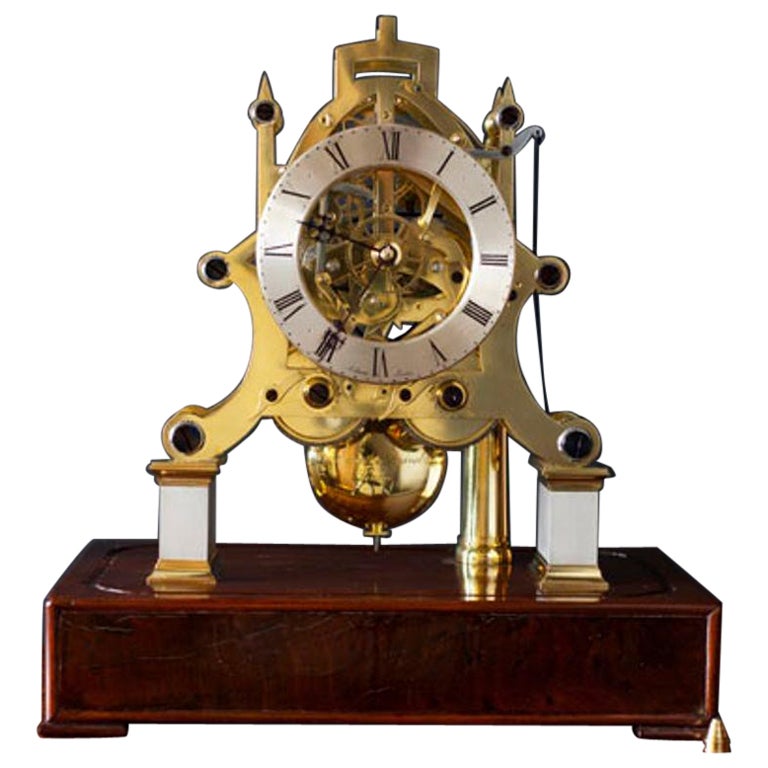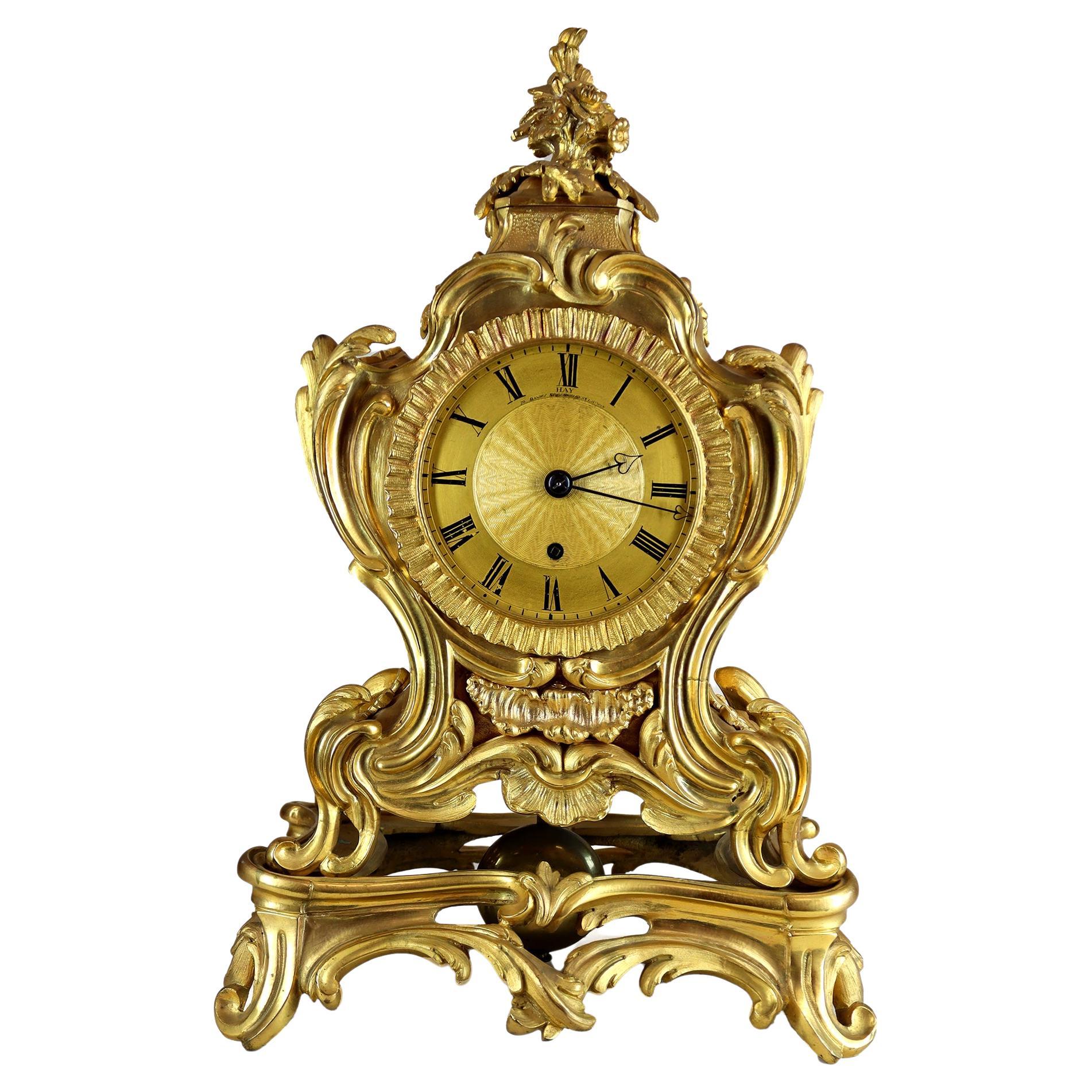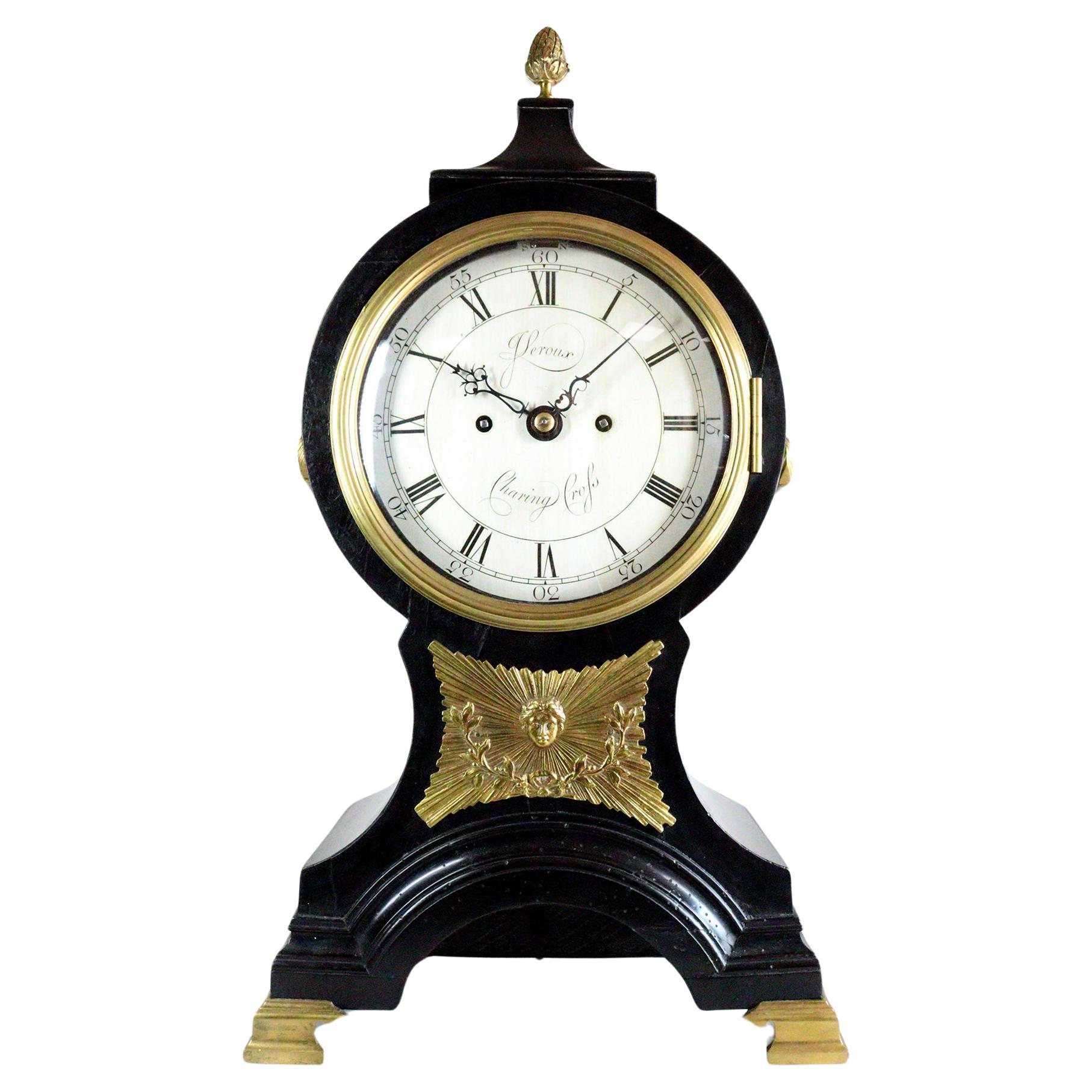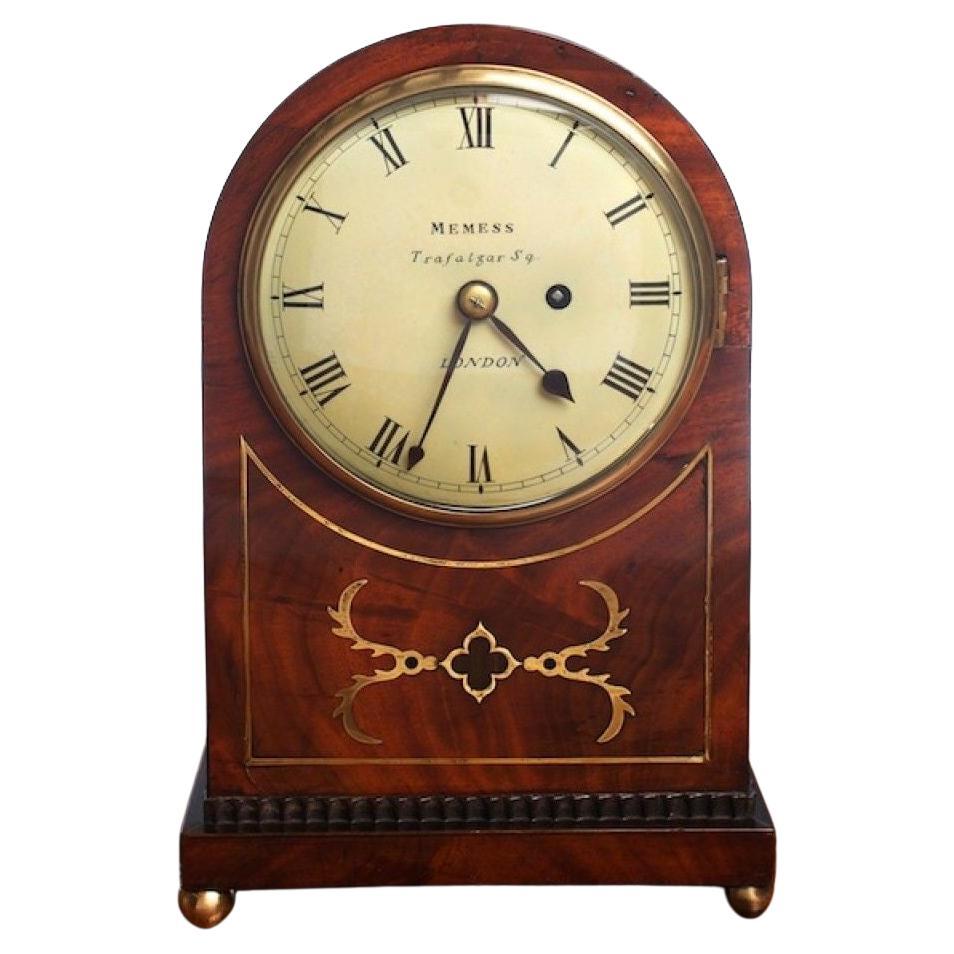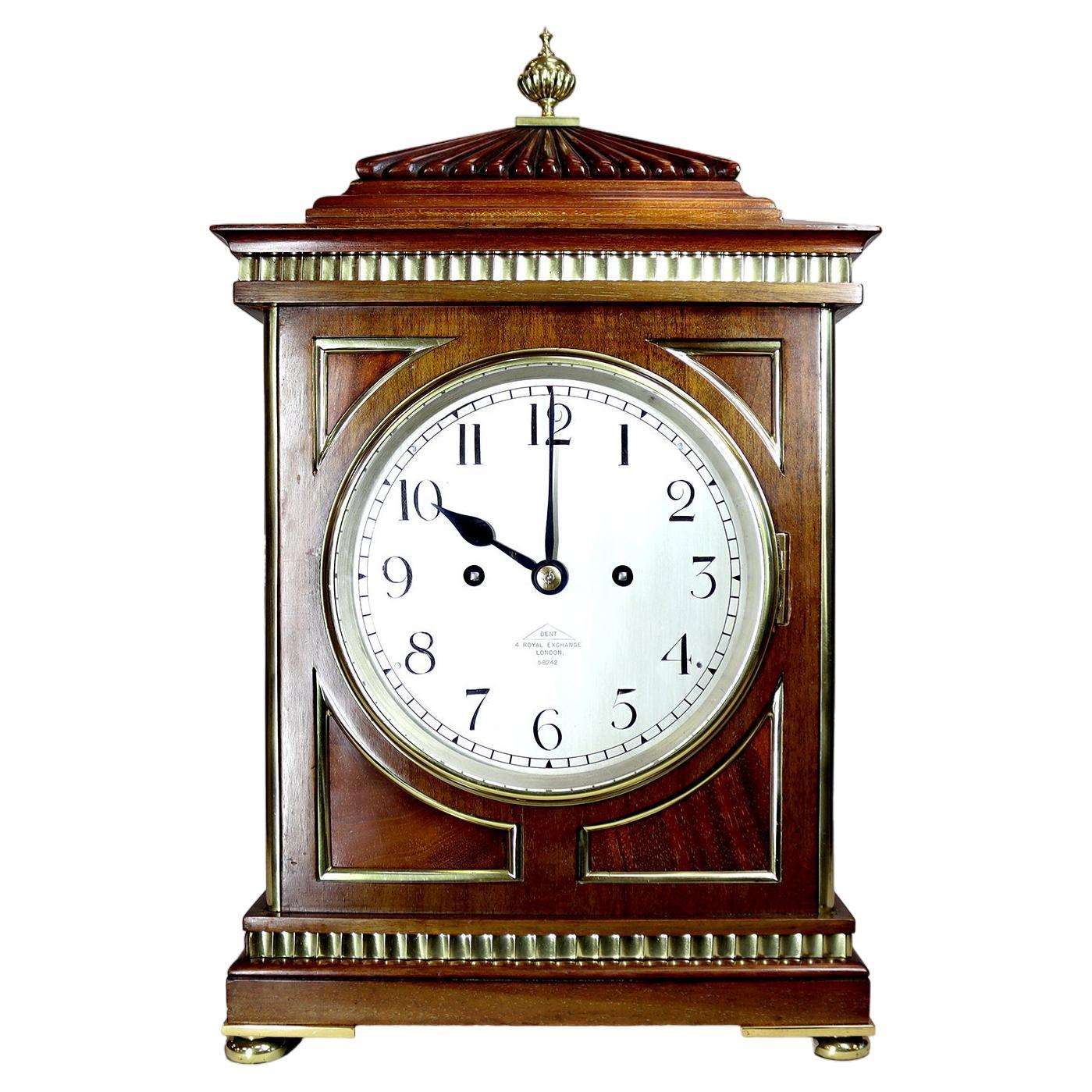Items Similar to Miniature Single Fusee Bracket Clock By William Johnston, Strand, London
Want more images or videos?
Request additional images or videos from the seller
1 of 19
Miniature Single Fusee Bracket Clock By William Johnston, Strand, London
About the Item
An extremely small single fusee bracket clock in a scalloped mahogany case. The eight day movement having a half deadbeat escapement with a T bar pendulum with hold fast, is beautifully made and of particularly fine quality, signed “Wm Johnson Strand London” on the back plate and dial. The half deadbeat escapement was often used by high quality english makers such as Grimalde & Johnson and Vulliamy. The 3 inch silvered dial, framed by a gilded engine bezel, has fine blued steel pierced heart hands.
The unusual case veneered in mahogany in the form of a stylalised scallop shell supported on foliate scroll work forming the feet.
William Johnston is first recorded in partnership with Peter Grimalde between 1815 and 1825, before setting out on his own, Grimalde & Johnston were celebrated precision chronometer makers, Johnson continued to work in the same style and vein at 50 The Strand until 1851, and was famed for his diminutive bracket clocks, examples of Johnsons work can be found in the Greenwich Royal Observatory Collection.
Date 1830’s
“Britten’s Old Clock & Watches, and Their Makers” 1982 edition
“The Georgian Bracket Clock 1714-1830” Richard Barber 2001 edition
This clock is serviced and comes with our two year guarantee
- Creator:Johnson (Clockmaker)
- Dimensions:Height: 8.67 in (22 cm)Width: 5.52 in (14 cm)Depth: 3.94 in (10 cm)
- Style:William IV (Of the Period)
- Materials and Techniques:
- Place of Origin:
- Period:
- Date of Manufacture:1830-1839
- Condition:Wear consistent with age and use.
- Seller Location:Amersham, GB
- Reference Number:
About the Seller
No Reviews Yet
Vetted Seller
These experienced sellers undergo a comprehensive evaluation by our team of in-house experts.
1stDibs seller since 2023
- ShippingRetrieving quote...Ships From: Amersham, United Kingdom
- Return PolicyA return for this item may be initiated within 14 days of delivery.
More From This SellerView All
- Single Fusee Mantel clock by Hay LondonBy HAYLocated in Amersham, GBAn unusual english single fusee mantel clock in a Louis XV style rocaille ormolu case in the french taste. The eight day fusee movement is of superb quality with a pendulum descendin...Category
Antique Early 19th Century British Rococo Mantel Clocks
MaterialsBronze
- John Leroux, London. Twin Fusee Bracket ClockBy John LerouxLocated in Amersham, GBAn 18th century balloon shaped bracket or table clock by John Leroux of Charing Cross, dating from circa 1790. The waisted case surmounted by a brass pineapple finial over a drum hou...Category
Antique 18th Century English George III Mantel Clocks
MaterialsBrass
- A Twin Fusee Bracket Clock By DentBy DentLocated in Amersham, GBA striking two train bracket clock of exceptional quality by one of the great nineteenth century makers. The eight day twin fusee movement strikes on a blued steel gong behind a silvered arabic dial, signed Dent and numbered 58242 on both th dial and the back plate. Housed in a solid mahogany case with brass mounts and a gadrooned pergoda top surmounted by an acorn finial, and supported by bun feet. The sides ar pierced with attractive fish scale sound vents lined with dark blue velvet. The movement and case are both of remarkable quality, as you would expect from a clock made by Dent. The history of Dent & Co. spans three centuries of precision watch and clock making in Great Britain. Established in 1814 by Edward J. Dent, the company embraced the Victorian fervour for technological innovation and created precision chronometers to navigate the Royal Navy and guide some of the most intrepid explorers on their voyages. The British Empire was in full expansion and its maritime tradition had produced some remarkable technological breakthroughs from the late 18th century. Propelling the impetus of Britain’s primacy, Dent proved a key player in Victorian horological history manufacturing the Standard Clock at the Royal Observatory, Greenwich which was to keep “Greenwich Mean Time” the time to which all others in the Empire were referred (better known today as G.M.T.) and continued to do so until replaced by an electronic clock in 1946. Dent also made probably the most famous clock in the world - the Great Clock for the Houses of Parliament, familiarly known as Big Ben. Dent’s reputation soared and their chronometers accompanied some of the century's most influential and colourful explorers. Dent chronometer...Category
Antique Early 1900s English High Victorian Mantel Clocks
MaterialsBrass, Steel
- Twin Fusee Bracket Clock By Barraud And LundLocated in Amersham, GBA striking drum head bracket clock by Barraud and Lund of exceptional quality. The case is made of quarter sawn mahogany with a beautifully crisp silv...Category
Antique Mid-19th Century English Victorian Mantel Clocks
MaterialsBrass
- An Impressive Fusee Dial Clock By Shore, LondonLocated in Amersham, GBAn impressive fusee timepiece by J.Shore. The high quality eight day four columnar pillar single chain fusee movement and thick brass plates is in excellent condition. Housed in a ca...Category
Antique 1830s English Regency Wall Clocks
MaterialsBrass, Steel
- Goliath Single Fusee Dial Clock or Station ClockLocated in Amersham, GBThis giant single fusee dial clock would have been made for a public space like a railway station. Made By Swinden and Sons of Birmingham, it has a su...Category
Antique 1880s English Late Victorian Wall Clocks
MaterialsBrass, Steel
You May Also Like
- George III Mahogany English Fusee Bracket Clock by William Chater, LondonLocated in Norwich, GBGeorge III Bracket Clock. Stunning mahogany case with Cupola top surmounted by a ‘pineapple’ finial, profusely inlaid with brass, fishscal...Category
Antique 1810s English George III Table Clocks and Desk Clocks
MaterialsMahogany
- William IV Double Fusee Skeleton Clock by A. Stewart, LondonLocated in Norwich, GBA William IV Skeleton clock of fine quality with two massive scroll plates sitting on rectangular, silvered plinths and standing on a mahogany base with block feet. Eight day doubl...Category
Antique 1830s English William IV Mantel Clocks
MaterialsBrass
- Regency Mahogany English Fusee Bracket Clock by Memmes, LondonLocated in Norwich, GBRegency bracket clock in an arch top case with brass inlay and dentil moulding, side carrying handles and standing on four brass ball feet. Painted dial with Roman numerals and original spade hands signed ‘Memess, Trafalgar Square, London’. Glazed rear door to the fine quality eight day single fuse movement with arch shaped plates and ‘regulating’ pendulum. C.1820. ‘Watchmakers and clockmakers of the world’ by Brian Loomes...Category
Antique 1820s English Early Victorian Table Clocks and Desk Clocks
MaterialsMahogany
- George III Mahogany Twin Fusee Verge Bracket Clock by Thomas Pace, LondonBy Thomas PaceLocated in Norwich, GBGeorge III Bell Top Bracket Clock Fine flame mahogany case with ormolu mounts and ormolu caryatids standing on bracket feet. Silvered dial with subsidiary dial for strike/silent,...Category
Antique 1780s English George III Table Clocks and Desk Clocks
MaterialsMahogany
- Mahogany Library Fusee Bracket Clock by Norman, PimlicoLocated in Norwich, GBLibrary bracket clock by Norman, Pimlico Finely figured mahogany case with ebony mouldings standing on a stepped moulded plinth and resting on pad feet with bevelled glass viewi...Category
Antique 19th Century British More Clocks
MaterialsMahogany
- George III Miniature Twin Fusee Mantel Clock, Hunter London, circa 1790By William HunterLocated in Melbourne, VictoriaAn exceptionally rare George III miniature twin fusee mantel clock, circa 1790. The mahogany break arch case with brass sound frets to the sides and detailed decoration to the front of the case, with decorative fern patterned swept feet and top carry handle. The rear winding movement of diminutive proportions, with pull repeat, and profusely engraved backplate with swags of flowers and the Prince of Wales feathers in a central cartouche, currently converted from verge to anchor escapement. The white painted arched dial inscribed with the name of the maker, Hunter, London. This probably represents Thomas & William Hunter...Category
Antique 18th Century British George III Mantel Clocks
MaterialsBrass
Recently Viewed
View AllMore Ways To Browse
Dupont Travel Clock
Jaeger Lecoultre Marble Clock
Jaeger Lecoultre Marble
Lalique Owl Clock
Jaeger Lecoultre Pendulette
Jerome Clock
Minute Repeat
Goliath Clock
Kienzle Clocks On Sale
Luxor Table Clock
Modele Depose Meaning
Sebastian Wong
Solari Cifra 5
Tiffany And Co Clock Swiss Made
Tiffany And Co Brass Desk Clock
Tiffany And Co Swiss Made Desk Clock
Time Zone Desk Clock
Seiko Vintage 1980

